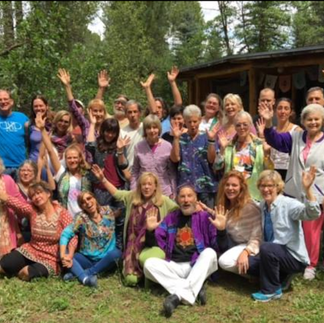The Hummingbird Community
- epsteieb
- Jan 31, 2022
- 6 min read
Location: Mora, New Mexico
(Between Santa Fe and Taos)
On 500 acres of pristine, mountain land. The lowest elevation was at 8,000 ft. and the highest is at 10,000.
Residents: 20 - 18 full time, 2 intermittent and 1 volunteer
Year Established: 1996
Land size: 500 acres
Hummingbird was founded in 1996 by a core group converging from different parts of the country that are a part of a non-profit organization, Global Family.
Vision:
Cultivating a soul-centric culture of interconnectedness with Earth and all life.
Mission:
With this exquisite land as a master teacher, they are an intergenerational learning center providing in-depth experiences with the wisdom of Nature, practical tools for regenerative living, and opportunities for co-creating innovative solutions for whole systems health.
Social Dynamics:
Ages of the residents: Adults: 50-78, - one volunteer, 24
Societal Behavior: Very open, honest, and committed to consciously learning and questioning their behavior and beliefs.
The expansive space on the land and offsite jobs enabled the residents to only interact during weekly meetings and when they chose to. We believe this space gave the residents more privacy, autonomy and enhanced their overall experience
We participated in a 4 -day orientation on co-creative collaboration. The focus was on self-responsibility and learning how to truly collaborate with others in a positive way.
This was a life-changing experience for us and truly changed the way Hal and I interact with each other and all people. Most of the teachings were focused on taking responsibility for our own behaviors and thoughts, honest communication, and respecting others and their paths.
Infrastructure:
The campgrounds feature a large, restaurant-quality community kitchen, strawbale bathhouses for men and women, an outdoor dining room, soothing gathering yurt, meditation labyrinth, and a beautiful mountain hiking trail.
From the outside, The Grace House is a nicely manicured double-wide trailer. It has 5 bedrooms, 3 baths, and a fully equipped kitchen. They use it for a community office, community living, and some guest rooms. It has dance-quality bamboo floors and lots of windows and light.
The Ease House is a 2 story structure that is built with green design and materials. The walls incorporate earth-pressed blocks that are made with local soil using their community-owned machine.
Some of this structure is occupied by community members, there are 6 bedrooms available that sleep 2 people each with an adjacent bathroom and kitchen for program participants or visitors.
All other houses were artfully built with locally- sourced soil, timber, and straw.
Electricity:



90% of their electricity is solar-generated. On cloudy days, a diesel generator is used and they use stove pipes to keep the houses warm with wood from their land.
Water:
Their water comes from the fresh snowmelt coming down the overhead mountain caps and fed into wells below.
They have an overflow pond for water conservation and use aquaponic techniques for gardening.
Water Management:
Composting toilets are used in the campgrounds for visitors. Most members urinate outside and a few residents consistently used composting toilets near their individual housing.
Composting toilets As are similar to outhouses except there is no smell because with each deposit, you cover it completely with sawdust, diatomaceous earth, peat moss, or other sustainable dry material.
They use this generated waste to feed fruit trees after the waste has composted for a few years.
Those who do not use a composting toilet use low-flow toilets on the city water grid.
They make a conscious choice not to purchase items with plastic packaging, so not much “trash” exists. They recycle and reuse almost everything.
Kitchen scraps that compost relatively quickly are saved for the garden and chickens.
Farming:
One couple, Sunny and Sequoia (who are featured in these videos:
tend the largest garden and the animals. They eat about 90% out of the garden.
The rest eat about 40% out of the garden. They have connections with local farmers and purchase most of their other produce and goods from these local, organic growers.
300+ days per year of brilliant New Mexico sunshine provides an extended greenhouse growing season.
They have several greenhouses and window beds. They plant by moon cycles. Different plants have been shown to grow heartier when planted during certain phases of the moon.
They used composting food, animal, and human manure for fertilizer.
They have 14,000 sq ft garden space. They grow several organic and heirloom varieties of just about every well-known vegetable.
Animal Husbandry:
Happy, free-range dairy goats and chickens are cared for by two of the residents.
The goats supply milk and dairy for cheese and the males provide meat.
The chickens supply eggs and meat. They also supply high-quality manure for the garden. In addition, their coop is next-door to the greenhouse so the heat from their bodies and manure help keep the greenhouse warm.
Bees are kept to help increase the bee population and they leave the honey for the bees.
Health and Wellbeing:
All of the residents were very healthy. They hold weekly yoga classes that most residents participate in. Healthy eating and frequent exercise was a main priority. They practiced homeopathy and used herbal remedies.
As of yet, we found the members of this village to be the most content.
Everyone seemed genuinely honest, open, and enthusiastic about life
The resident artist creates art on a daily basis. She paints, sculpts, carves, creates stained glass. She also leads a weekly yoga class and helps to tend the garden they call Dancing Colors which she dedicates entirely to flowers for the bees.
The community celebrates all life events together and music and dancing main staples of these events.
Conflict Resolution:
The residents collaboratively created Co-Creators Agreements. All members agree to adhere to them.
One of the most important agreements is that if a conflict arises, it needs to be quickly acknowledged and resolved peacefully with all parties involved.
They also have self-responsibility agreements that ask each resident to acknowledge that he or she is responsible for his or her own reactions and behavior.
Children:
Two of the co-founders, Katharine and Makasha Roske are particularly impassioned to make a Hummingbird a sanctuary for children where they are honored as unique divine beings and empowered to express their gifts to the world. Learning from the wisdom inherent in nature, the young people are supported in staying connected with their hearts and their inner truth. They are taught in a prayerful way to respect the land and each other. As Hummingbird is inter-generational, people of all ages are invited to retreat, rejuvenate and reflect on the meaning in their lives.
The Roske’s also created a youth environmental activist group with their children and grandchildren called “The Earth Guardians” in Colorado!
This organization of dedicated youth from around the world committed to standing up and protecting the Earth, Water, Air and Atmosphere.
Highlights:
We got to stay here for ten days and the biggest highlight for us was their commitment to consciousness and compassion. Everyone, we spent time with acted and spoke with intention and kindness. They asked deep, personal questions and showed compassion and contemplation for all answers. They hugged deeply and smiled warmly.
An equally breathtaking highlight was the pristine, lush land. The only way we can describe the area is how we imagine heaven would look like.
Wildflowers cover the land, lush green grass, tall trees, rolling mountains, endless skies.
Manna Rose:
Greenhouse geo-dome was made from a mail-order kit. The garden beds were designed to follow the movement of the moon and crops are planted by the moon cycles based on biodynamic farming techniques.
Buckminster Fuller’s geodesic dome design with the ingenuity of a lifelong dedicated gardener and the modern technology of double-wall polycarbonate greenhouse panels, this community was able to grow so much more than would be possible otherwise all year-round!
The 30 foot greenhouse was designed by Utgar Parsons of Growing Spaces in Pagosa Springs , Colorado.
The Wellnest Center:
A health and wellness center open to the community and the public.
















































































Comments